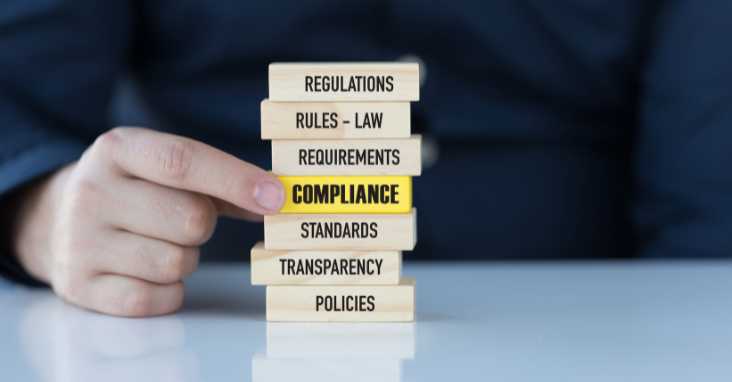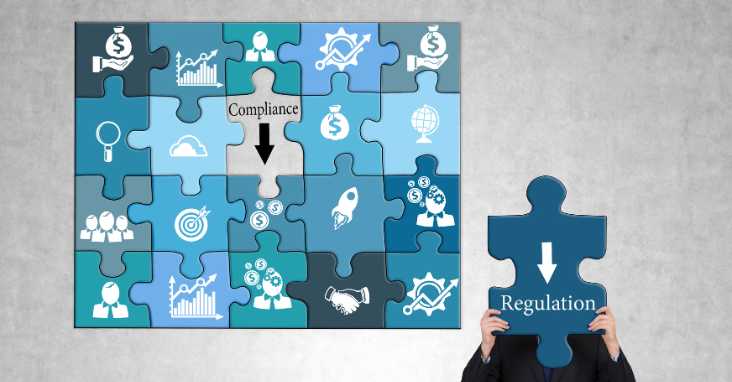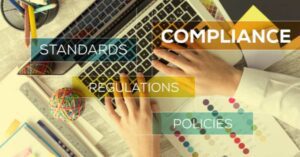Let’s talk about compliance software. It might sound like a dry topic, but stick with me. This could be the game changer your business has been looking for, especially if you’ve ever felt overwhelmed by the mountain of regulations and industry standards that you need to meet.
Compliance software streamlines regulatory adherence, enhances data security, and improves operational efficiency, crucial for businesses facing complex legal and regulatory requirements.
Think about it. Every industry, whether it’s healthcare, finance, or manufacturing, has its own set of regulations. Keeping up with these ever-changing rules is like trying to hit a moving target while blindfolded. It’s tough, right? That’s where this compliance tracking software comes in. It’s like having a GPS in the complex world of regulations. This software doesn’t just keep you on the right path; it also helps you avoid the costly penalties and reputational damage that come from non-compliance.
In this extensive guide, I’m going to take you through everything you need to know about compliance software. From understanding what it is, to choosing the right one for your business, we’ve got a lot to cover. So grab a cup of coffee, and let’s dive in!

What is Compliance Software?
The Backbone of Regulatory Management
Imagine you’re running a marathon, but the path is constantly changing, and there are hurdles you can’t always see. That’s what staying compliant often feels like for businesses. Compliance software acts like a dynamic map and a hurdle detector, guiding you through the complex terrain of regulations and standards.
A Closer Look at Its Capabilities
Automated Workflows: – Manual processes, compliance processes are prone to errors and incredibly time-consuming. Compliance software automates these workflows, ensuring that manual tasks like data collection, reporting, and monitoring are handled efficiently and accurately.
Centralized Data Management: This software creates a centralized repository for all your compliance-related data. Think of it as a digital filing cabinet that’s far more organized and accessible than traditional methods.
Real-Time Regulatory Updates: Staying current with regulatory changes can be a full-time job. Compliance software simplifies this by providing real-time updates on new and amended regulations.
Risk Assessment Tools: Identify potential for compliance violations system failures and risks before they become issues. These tools analyze your data and processes, flagging areas that might pose a risk of non-compliance.
Beyond the Basics: Advanced Features
Customizable Reporting: Need to present compliance data to stakeholders or regulatory bodies? Compliance software can generate customizable custom reports, that make complex data easy to understand.
Integration with Other Systems: The best compliance software doesn’t work in isolation. It integrates seamlessly with other systems like HR, finance, and operations to provide a holistic view of compliance across your organization.
User-Friendly Dashboards: User experience is key. These dashboards provide a clear view of compliance statuses comprehensive reports, tasks, and alerts, making it easier for teams to stay informed and take action.
Tailored to Industry Needs
What’s fascinating about compliance software is how it’s tailored to different industries. For example, a healthcare provider will have different compliance needs (like HIPAA compliance) compared to a financial institution concerned with Sarbanes-Oxley Act (SOX) compliance. Software developers understand this and create specialized compliance tools to that cater to these highly regulated industries’ unique requirements.
The Human Element
While compliance software offers automation and efficiency, it doesn’t replace the need for human oversight. It enhances the ability of compliance officers and compliance teams to do their jobs more effectively, giving them the tools and data they need to make informed decisions.
Key Points Summary:
- Compliance software automates and streamlines regulatory compliance tasks.
- It offers real-time updates on regulations, centralized data management, and risk assessment tools.
- Advanced features include customizable reporting, system integration, and user-friendly dashboards.
- Industry-specific solutions address unique regulatory challenges.
- The software enhances, not replaces, human expertise in compliance management.
In essence, compliance software is like having a highly skilled, always-updated, and tirelessly working compliance expert in your team, helping you navigate the labyrinth of industry regulations with ease and confidence.

Why Do You Need Compliance Software?
The Ever-Growing Complexity of Regulations
The first thing you need to know is that the world of regulations is not static; it’s more like a living, breathing entity that constantly evolves. New laws and amendments are introduced regularly, and keeping up with them manually is akin to chasing a constantly moving target. Compliance software is your steady hand in this turbulent environment.
Cost of Non-Compliance: More Than Just Fines
Many people think the cost of non-compliance multiple regulations is just financial, in terms of fines and penalties. But there’s more to it:
Reputation Damage: A compliance breach can harm your brand’s reputation, leading to loss of customer trust, which is often more costly than any fine.
Operational Disruptions: Non-compliance issues can lead to operational halts, impacting your business continuity.
Legal Repercussions: Beyond fines, there can be legal battles, which are costly and time-consuming.
Enhanced Efficiency and Productivity
Compliance software streamlines business processes further, freeing up your team’s time to focus on core business activities rather than getting bogged down by compliance paperwork. It’s like shifting from manual labor to automation in a factory setting.
Proactive Risk Management
With the right compliance monitoring software, you can move from a reactive to a proactive stance. Instead of waiting for issues to arise, you’re constantly scanning the horizon and mitigating risks before they become problems.
Data Security and Privacy
In an age where data breaches are common, compliance software helps ensure that your data handling practices internal controls are up to par, especially if you’re dealing with sensitive customer data. This is critical for maintaining trust and complying with regulations like GDPR or HIPAA.
Global Compliance Made Easier
For businesses operating across borders, compliance software is invaluable in managing compliance risks too. Different countries have different regulations, and keeping track of all these regulatory obligations can be a Herculean task. Compliance software can be tailored to manage multi-national compliance requirements.
Better Decision Making
With comprehensive data and analytics at your fingertips, you can make better-informed decisions about your business operations. Compliance software provides instant access to insights that can guide strategic planning and risk management.
Key Points Summary:
- Compliance software helps navigate the ever-evolving landscape of regulations.
- It mitigates the costs of non-compliance, which extend beyond fines to include reputational damage and legal repercussions.
- The software enhances operational efficiency and productivity.
- It enables proactive risk management and ensures data security.
- The tool is indispensable for global businesses managing multi-national compliance.
- It provides valuable insights for informed decision-making.
In short, compliance software is like a lighthouse guiding your business through the fog of regulatory challenges. It not only ensures that you’re compliant but also elevates your operational efficiency, risk and compliance management processes demonstrate compliance,, and strategic decision-making capabilities.

Choosing the Right Compliance Software
Assessing Your Specific Needs
Understand Your Regulatory Environment: Each industry has its unique regulatory challenges. A financial institution, for instance, will have different compliance requirements than a healthcare provider. Start by thoroughly understanding the regulations specific to your industry.
Evaluate Your Business Size and Complexity: The size of your business and the complexity of your operations play a crucial role. A small business might need a simpler solution compared to a multinational corporation.
Key Features to Look For
Customization and Scalability: The software should not only meet your current needs but also grow with your business. Look for solutions that offer customization to adapt to your changing requirements.
User-Friendly Interface: A complicated tool will only add to your challenges. Choose software that is intuitive and easy to use, minimizing the learning curve for your team.
Integration Capabilities: The ability to integrate with your existing systems (like ERP, CRM, etc.) is crucial. This ensures a seamless flow of information and a unified approach to all compliance and compliance related activities.
Reporting and Analytics: Good compliance software should offer robust reporting features, allowing you to generate insightful, compliance reports and audit reports effortlessly.
Automated Alerts and Notifications: Stay on top of compliance tasks with automated alerts and notifications about due dates, changes in regulations, and other critical compliance events.
Vendor Reputation and Support
Research the Vendor’s Track Record: Look into the vendor’s history and reputation in the market. Read customer reviews and case studies to understand their reliability and service quality.
Support and Training Services: Ensure that the vendor offers comprehensive support and training. This is vital for smooth implementation and ongoing usage of the software.
Cost Considerations
Understanding Pricing Models: Compliance software can come with various pricing models – from subscription-based to one-time licensing fees. Understand the total cost of ownership, including any additional costs for updates or support.
Return on Investment (ROI): While cost is a factor, also consider the ROI. Effective compliance software can save money in the long run by preventing non-compliance penalties and increasing operational efficiency.
Trial and Demos
Request a Demo: Before making a final decision, request a demo to see the software in action. This will give you a better understanding of its capabilities and whether it aligns with your needs.
Free Trials: If available, take advantage of free trials. This hands-on experience can be invaluable in assessing whether the software fits your business.
Key Points Summary:
- Assess your industry-specific regulatory needs and the complexity of your business.
- Look for software that offers customization, user-friendliness, integration capabilities, robust reporting, and automated alerts.
- Research the vendor’s reputation and ensure they provide strong support and training.
- Consider the pricing models and the potential ROI.
- Request demos and take advantage of free trials to make an informed decision.
Choosing the right compliance software is like selecting a partner for your business’s compliance journey. It requires careful consideration of your specific needs, a thorough evaluation of the software’s features, and an understanding of the value it brings to your business. With the right tool in hand, you can navigate the complex world of regulations with confidence and ease.

Implementing Compliance Software
Developing a Strategic Implementation Plan
Assess Current Processes: Before implementing new software, understand your current compliance processes. Identify what’s working and what’s not, and where the software can bring improvements.
Set Clear Objectives: Define what you want to achieve with the compliance software. This could range from automating compliance tasks to doing audit management, improving data security or ensuring real-time regulatory updates.
Stakeholder Engagement: Involve key stakeholders from the start. This includes management, IT, compliance and security teams, and end-users. Their input is crucial for a successful implementation.
Training and Change Management
Comprehensive Training Programs: Organize training sessions for all users. This ensures that your team is comfortable and proficient with the new software.
Address Resistance to Change: Change can be challenging. Address any concerns or resistance head-on by highlighting the benefits of the new system and providing adequate support during the transition.
Data Migration and System Integration
Seamless Data Transfer: Plan for the migration of existing compliance data into the new system. This should be done with minimal disruption to your operations.
Integrating with Existing Systems: Ensure the compliance management systems software integrates well with your other business systems. This integration is key for a unified and efficient compliance management system workflow.
Testing and Quality Assurance
Pilot Testing: Conduct pilot tests to see how the software performs in a real-world scenario. This helps identify any issues or gaps that need addressing before full-scale implementation.
Feedback Loop: Create a feedback mechanism where users can report issues or suggest improvements. This continuous feedback is vital for refining the implementation process.
Ongoing Monitoring and Improvement
Regular Performance Reviews: Once the software is implemented, regularly review its performance. Are you achieving the objectives set at the beginning?
Updates and Maintenance: Stay on top of software updates and maintenance. This ensures your compliance software remains effective and up to date with the latest regulatory changes.
Continual Improvement: Compliance is an ongoing process. Continually look for ways to improve your compliance program and make the most of your compliance software.
Key Points Summary:
- Start with a strategic plan, assessing current processes and setting clear objectives.
- Engage stakeholders and provide comprehensive training to ease the transition.
- Ensure seamless data migration and system integration.
- Conduct pilot testing and maintain a feedback loop for continuous improvement.
- Regularly monitor performance, and stay on top of updates and ongoing improvements.
Implementing compliance software is not just about installing a new tool; it’s about transforming your compliance processes and culture. It requires a well-thought-out approach, involving careful planning, stakeholder engagement, and ongoing evaluation and improvement. With a successful implementation, compliance software can become a powerful asset in managing regulatory challenges and strengthening your business’s compliance posture.

FAQs on Compliance Software
What is the Main Purpose of Compliance Software?
Compliance software helps businesses adhere to legal, regulatory, and policy requirements, reducing the risk of fines and legal issues. It automates and streamlines compliance-related tasks, making the compliance management process more efficient and reliable.
How Does Compliance Software Ensure Data Security?
Many compliance software tools come with built-in security features like encryption, access controls, and audit trails. They help in safeguarding sensitive data and ensuring that data handling processes comply with regulations like GDPR and HIPAA.
Can Compliance Software Adapt to Changing Regulations?
Yes, one of the key strengths of compliance software is its ability to adapt to changing regulations. Most modern compliance software is updated regularly to reflect the latest legal and regulatory changes, ensuring that businesses remain compliant.
Is Compliance Software Suitable for Small Businesses?
Absolutely! Many compliance software solutions are scalable and offer customizable features that make them suitable for businesses of all sizes, including small and medium enterprises (SMEs).
What Types of Compliance Does This Software Cover?
Compliance software can cover a wide range of areas including financial compliance, healthcare and safety compliance, environmental regulations, data privacy laws, and HR and employment laws, depending on the specific tool and its features.
How Do I Know If My Business Needs Compliance Software?
If your business operates in a regulated industry or handles sensitive data (like customer information or patient records), you likely need compliance software to ensure you meet legal and regulatory standards.
What Should I Look for in a Compliance Software Vendor?
Look for a vendor with a strong track record, positive customer reviews, robust support and training options, and software that meets your specific compliance needs.
Can Compliance Software Replace Legal Advisers?
No, compliance software should be used in conjunction with legal advice, not as a replacement. It enhances your legal team’s ability to manage your compliance obligations but doesn’t substitute for professional legal counsel.
How Long Does It Take to See ROI from Compliance Software?
The time to see ROI can vary but generally, businesses notice improvements in efficiency and risk reduction shortly after implementation. Long-term ROI comes from avoiding non-compliance costs and operational efficiencies.
Does Compliance Software Require Technical Expertise to Operate?
While some technical understanding can be beneficial, most compliance compliance management software is designed to be user-friendly, with training and support provided by vendors to ensure compliance and ease of use.

Compliance Management Software Tools
RegTech – Financial Services Focus
Key Features: RegTech specializes in regulatory technology for the financial sector. It offers features like automated compliance checks, risk assessment, and real-time monitoring of regulatory changes.
Why It’s Useful: Ideal for banks, investment firms, and insurance companies, RegTech helps navigate complex financial regulations like SOX, Dodd-Frank, and GDPR.
HealthComply – Healthcare Industry Compliance
Key Features: Tailored for the healthcare industry, HealthComply focuses on patient data protection and compliance with regulations like HIPAA and HITECH.
Why It’s Useful: This tool is essential for healthcare providers, insurance companies, and entities dealing with sensitive health information, ensuring they stay compliant with patient privacy laws.
SafeGuard – Versatile Business Compliance
Key Features: SafeGuard offers a broad range of various compliance management solutions and tools suitable for various industries. It includes features for policy management, and incident management and tracking, and compliance training.
Why It’s Useful: It’s a great option for businesses looking for a comprehensive, all-in-one compliance solution that addresses multiple regulatory areas.
EcoTrack – Environmental Compliance
Key Features: EcoTrack is designed for businesses dealing with environmental regulations. It helps in tracking carbon footprint, waste management, and ensuring compliance with environmental laws.
Why It’s Useful: Perfect for manufacturing, energy, and construction sectors, EcoTrack assists in adhering to environmental standards and promoting sustainable practices.
CyberComply – Cybersecurity and Data Protection
Key Features: This tool focuses on cybersecurity compliance, offering features like vulnerability scanning, GDPR readiness risk assessments, and cyber risk management.
Why It’s Useful: For businesses prioritizing data security, especially in sectors like IT, finance, and e-commerce, CyberComply helps in adhering to cybersecurity regulations and protecting sensitive data.
HRComply – Human Resources and Employment Law
Key Features: HRComply provides solutions for employment law compliance, managing everything from employee training and onboarding to labor law adherence and equal employment opportunity regulations.
Why It’s Useful: Essential for HR departments across all industries, this tool ensures that employment practices are compliant with legal standards.
In today’s complex regulatory environment, having the right compliance software can make all the difference. Each of these tools offers unique features and benefits, tailored to specific industries and compliance needs. By choosing a tool that aligns with your business’s requirements, you can ensure that compliance management software helps you stay on top of regulatory challenges and maintain a strong compliance posture.

Conclusion
We’ve covered a lot of ground today, and I hope you’re feeling more confident about navigating the world of compliance software. Remember, this isn’t just about ticking boxes. It’s about safeguarding your business’s future and maintaining the trust of your customers and stakeholders. Compliance software isn’t just a tool; it’s a strategic asset.
In this journey, we’ve explored what compliance software is, its importance, how to choose the right one, and how to implement it successfully. It’s clear that the right compliance software can make a huge difference in how smoothly and efficiently your business operates.





